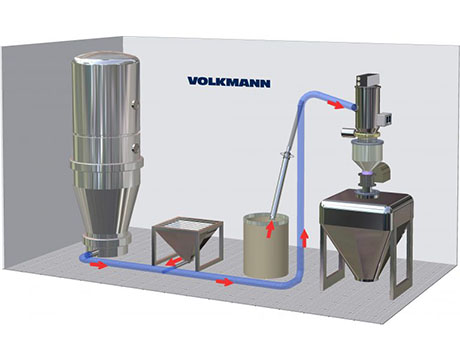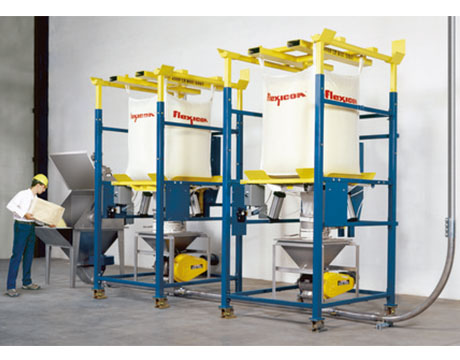Copyright © 2021 Zhangjiagang ChiYu Automation Equipment Co., Ltd. by iwonder.cn All rights reserved. Site Map
In today's highly automated manufacturing environments, efficiency, cleanliness, and precision are no longer optional—they are foundational. Whether in plastics compounding, pharmaceuticals, food processing, or chemical handling, one technology plays an increasingly central role in keeping these systems running smoothly: the vacuum conveying system. Unlike traditional mechanical transport methods, vacuum conveying provides a closed, clean, and energy-efficient solution to transferring bulk materials. This article explores how this system functions, why it's preferred, and what benefits it brings to modern industry.
A vacuum conveying system is a type of pneumatic transport mechanism that uses negative pressure (vacuum) to move powdery, granular, or pelletized materials through an enclosed pipeline. Rather than pushing materials through with compressed air or moving belts, the system pulls them—ensuring minimal contamination and spillage. These systems are commonly used in applications where material cleanliness, minimal operator exposure, and precise control are vital.
At its core, the system includes:
A vacuum pump or blower to generate negative pressure and drive air movement.
A material feed station where raw materials like powders or granules enter the system.
Transfer pipelines constructed from stainless steel or antistatic plastic to safely carry materials.
A filtering and separation unit that captures dust and fine particles before the material reaches the destination.
A receiving hopper or dosing system that collects and dispenses the material into processing equipment.
These components work together in a coordinated cycle, ensuring continuous, contamination-free transfer.

In legacy manufacturing plants, mechanical screw conveyors, belt systems, or manual bag-dumping were the standard methods for transferring bulk solids. While useful in specific applications, these methods fall short when hygiene, automation, or dosing precision becomes crucial.
Vacuum conveying systems are fully enclosed. This means there is no material leakage into the surrounding environment, drastically reducing dust and exposure to operators. In facilities handling fine powders, such as pharmaceutical excipients or plastic additives, dust control isn't just about cleanliness—it's a critical safety issue. Exposure to airborne particles can result in long-term health risks or explosive atmospheres.
Traditional conveyors often require straight runs or specific orientations due to gravity or mechanical constraints. In contrast, vacuum conveying systems offer unmatched flexibility. They can span long distances horizontally or vertically, navigate around structural obstacles, and reach tight or elevated spaces. This is especially advantageous in compact facilities or retrofitted plants where floor space is at a premium.
By integrating with dosing systems and programmable controllers, vacuum conveying enables factories to operate with greater precision and less human intervention. Automated vacuum cycles ensure that material quantities are delivered exactly as needed—crucial for batch consistency in mixing, extrusion, or compounding lines.
Each vacuum conveying system is built with modular components tailored to the material, flow rate, and production context. Understanding these components clarifies the technology's versatility and value.
The vacuum generator, typically a high-efficiency side-channel blower or rotary vane vacuum pump, creates the negative pressure needed to move materials. It is the central driving force of the system. The pump must be appropriately sized to handle both the material characteristics and the required conveying distance.
For example, lightweight powders like calcium carbonate require higher air velocities but less suction force than dense pellets or granules like PVC resin. The generator must be matched not just to the throughput, but also to the material's flow behavior and reactivity.
This is where the journey begins. Material is introduced into the system through a hopper or bin, often connected to a silo or bag dump station. Sensors monitor material levels and trigger feeding mechanisms like vibrating trays or rotary valves. For high hygiene applications, the hopper is equipped with dust-tight seals and anti-static linings.
Pipelines vary in diameter and material depending on the application. Stainless steel is standard for food and pharmaceutical processes due to its easy-to-clean surface and corrosion resistance. Antistatic polyethylene or polycarbonate is sometimes used for explosive materials. Proper pipeline design reduces pressure drops, material buildup, and particle degradation during transfer.
Before the conveyed material reaches the receiver, a filter-separator unit ensures that only solids are captured, while the air is exhausted cleanly. Filters may include HEPA elements, cyclone separators, or reverse-jet cleaning systems. This not only protects the final product but also prevents filter clogging and reduces maintenance downtime.
At the endpoint of the conveying line, material is discharged into a hopper, mixer, or storage bin. In many systems, this stage includes a weighing system or load cell that ensures dosing accuracy. Chiyu's system integrates weighing and feeding into a single module, allowing operators to automate recipes and avoid overuse of expensive additives or colorants.

Plastic manufacturing—especially in PVC production—is one of the areas where vacuum conveying shows its full strength. The process involves blending PVC resin with a combination of additives including:
Stabilizers: Prevent degradation during processing.
Lubricants: Improve flow and reduce friction.
Plasticizers: Enhance flexibility and reduce brittleness.
Pigments: Provide color uniformity.
Fillers: Add volume or adjust mechanical properties.
These materials differ in bulk density, particle size, and moisture sensitivity. Chiyu's vacuum conveying system is designed to manage each of them independently. For instance, lightweight pigments are conveyed at higher airspeeds with gentle separation to avoid dust formation. Heavier stabilizers may be conveyed in short bursts to reduce power consumption.
Consistent quality through automated batching and feedback loops.
Reduced material waste from dusting, overfeeding, or cross-contamination.
Shorter preparation time, enabling faster production cycles and reduced labor hours.
Cleaner environment, helping meet workplace safety and environmental compliance standards.
These advantages translate to tangible savings in energy costs, raw material use, and labor overhead.
Efficiency is a defining strength of vacuum conveying systems, especially when compared to legacy transport methods that consume high power or require continuous operation. Smart conveying systems operate on a batch-by-batch basis, consuming energy only when active.
Automated stop/start cycles controlled by level sensors.
Leak-proof fittings and high-seal gaskets that preserve suction efficiency.
Optimized filter media to minimize pressure drops and extend filter life.
Multi-line control systems to sequence several stations with one vacuum pump.
In systems like those provided by Chiyu, vacuum strength is automatically adjusted based on load demand, ensuring that the system never operates above what is required. This not only conserves energy but extends equipment lifespan.

Precision in modern manufacturing means more than just quantity—it means timing, sequencing, and material integrity. In industries such as pharmaceuticals, battery cell production, or engineered plastics, even a 1% deviation in ingredients can compromise the final product.
Vacuum conveying helps protect this consistency by:
Synchronizing material delivery with production equipment via digital PLC integration.
Avoiding contamination by transferring materials in fully sealed, sanitized pipelines.
Preventing oxidation or moisture uptake, which can degrade powders or alter chemical properties.
Providing stable batch records, essential for traceability and regulatory audits.
In regulated industries, these systems are often validated for Good Manufacturing Practices (GMP) compliance, with built-in options for Clean-in-Place (CIP) routines and audit trails.
No single system fits all. Selecting the correct vacuum conveying setup requires a careful match between material behavior and operational demands. Key factors include:
| Selection Factor | What to Consider |
|---|---|
| Material characteristics | Bulk density, abrasiveness, electrostatic charge |
| Throughput requirements | Volume per hour, surge demand capacity |
| Distance and elevation | Total pipeline length and vertical lifts |
| Sanitary requirements | Cleaning frequency, material contact safety |
| Control integration | PLC compatibility, batch feedback loops |
| Maintenance access | Filter accessibility, easy disassembly for cleaning |
A system that's overpowered wastes energy and increases wear. One that's undersized can create bottlenecks or material hang-ups. That's why early technical consultation is essential in specifying a system that performs optimally across the intended product range and production schedule.
Vacuum conveying systems have become essential tools in the modernization of industrial production. By enabling clean, efficient, and precisely controlled material transfer, they not only streamline operations but also enhance product quality and workplace safety. For manufacturers aiming to adopt more intelligent and automated processes, investing in a reliable conveying solution can lay the groundwork for long-term efficiency and growth. Companies like Chiyu continue to provide engineered vacuum conveying systems that support high-performance mixing, precise dosing, and seamless integration across a wide range of industrial applications.
Contact us: chiyumixer001@chiyumixer.com | www.chiyumixer.com